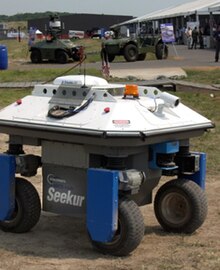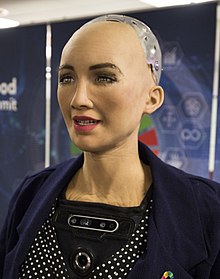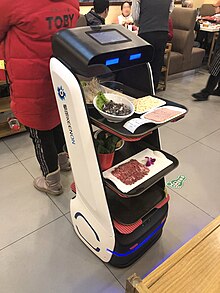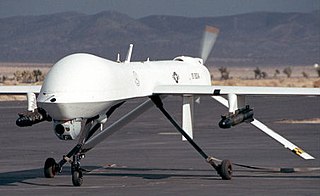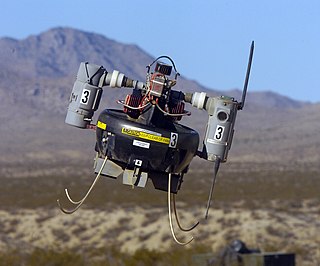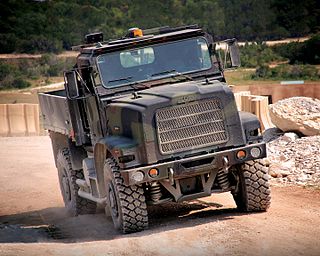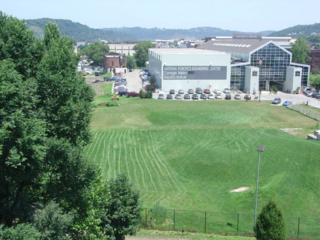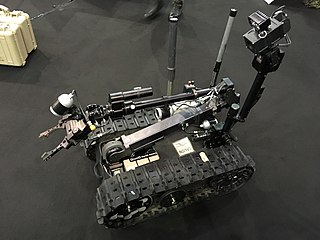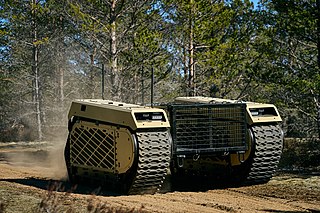Components and criteria of robotic autonomy
This section needs additional citations for verification .(December 2020) |
Self-maintenance
The first requirement for complete physical autonomy is the ability for a robot to take care of itself. Many of the battery-powered robots on the market today can find and connect to a charging station, and some toys like Sony's Aibo are capable of self-docking to charge their batteries.
Self-maintenance is based on "proprioception", or sensing one's own internal status. In the battery charging example, the robot can tell proprioceptively that its batteries are low and it then seeks the charger. Another common proprioceptive sensor is for heat monitoring. Increased proprioception will be required for robots to work autonomously near people and in harsh environments. Common proprioceptive sensors include thermal, optical, and haptic sensing, as well as the Hall effect (electric).
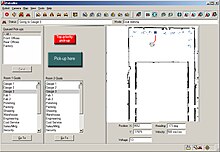
Sensing the environment
Exteroception is sensing things about the environment. Autonomous robots must have a range of environmental sensors to perform their task and stay out of trouble. The autonomous robot can recognize sensor failures and minimize the impact on the performance caused by failures. [1]
- Common exteroceptive sensors include the electromagnetic spectrum, sound, touch, chemical (smell, odor), temperature, range to various objects, and altitude.
Some robotic lawn mowers will adapt their programming by detecting the speed in which grass grows as needed to maintain a perfectly cut lawn, and some vacuum cleaning robots have dirt detectors that sense how much dirt is being picked up and use this information to tell them to stay in one area longer.
Task performance
The next step in autonomous behavior is to actually perform a physical task. A new area showing commercial promise is domestic robots, with a flood of small vacuuming robots beginning with iRobot and Electrolux in 2002. While the level of intelligence is not high in these systems, they navigate over wide areas and pilot in tight situations around homes using contact and non-contact sensors. Both of these robots use proprietary algorithms to increase coverage over simple random bounce.
The next level of autonomous task performance requires a robot to perform conditional tasks. For instance, security robots can be programmed to detect intruders and respond in a particular way depending upon where the intruder is. For example, Amazon (company) launched its Astro for home monitoring, security and eldercare in September 2021. [2]
Autonomous navigation
Indoor navigation
For a robot to associate behaviors with a place (localization) requires it to know where it is and to be able to navigate point-to-point. Such navigation began with wire-guidance in the 1970s and progressed in the early 2000s to beacon-based triangulation. Current commercial robots autonomously navigate based on sensing natural features. The first commercial robots to achieve this were Pyxus' HelpMate hospital robot and the CyberMotion guard robot, both designed by robotics pioneers in the 1980s. These robots originally used manually created CAD floor plans, sonar sensing and wall-following variations to navigate buildings. The next generation, such as MobileRobots' PatrolBot and autonomous wheelchair, [3] both introduced in 2004, have the ability to create their own laser-based maps of a building and to navigate open areas as well as corridors. Their control system changes its path on the fly if something blocks the way.
At first, autonomous navigation was based on planar sensors, such as laser range-finders, that can only sense at one level. The most advanced systems now fuse information from various sensors for both localization (position) and navigation. Systems such as Motivity can rely on different sensors in different areas, depending upon which provides the most reliable data at the time, and can re-map a building autonomously.
Rather than climb stairs, which requires highly specialized hardware, most indoor robots navigate handicapped-accessible areas, controlling elevators, and electronic doors. [4] With such electronic access-control interfaces, robots can now freely navigate indoors. Autonomously climbing stairs and opening doors manually are topics of research at the current time.
As these indoor techniques continue to develop, vacuuming robots will gain the ability to clean a specific user-specified room or a whole floor. Security robots will be able to cooperatively surround intruders and cut off exits. These advances also bring concomitant protections: robots' internal maps typically permit "forbidden areas" to be defined to prevent robots from autonomously entering certain regions.
Outdoor navigation
Outdoor autonomy is most easily achieved in the air, since obstacles are rare. Cruise missiles are rather dangerous highly autonomous robots. Pilotless drone aircraft are increasingly used for reconnaissance. Some of these unmanned aerial vehicles (UAVs) are capable of flying their entire mission without any human interaction at all except possibly for the landing where a person intervenes using radio remote control. Some drones are capable of safe, automatic landings, however. SpaceX operates a number of Autonomous spaceport drone ships, used to safely land and recover Falcon 9 rockets at sea. [5]
Outdoor autonomy is the most difficult for ground vehicles, due to:
- Three-dimensional terrain
- Great disparities in surface density
- Weather exigencies
- Instability of the sensed environment
Open problems in autonomous robotics
| | This section needs expansion. You can help by adding to it. (July 2008) |
There are several open problems in autonomous robotics which are special to the field rather than being a part of the general pursuit of AI. According to George A. Bekey's Autonomous Robots: From Biological Inspiration to Implementation and Control, problems include things such as making sure the robot is able to function correctly and not run into obstacles autonomously. Reinforcement learning has been used to control and plan the navigation of autonomous robots, specifically when a group of them operate in collaboration with each other. [6]
- Energy autonomy and foraging
Researchers concerned with creating true artificial life are concerned not only with intelligent control, but further with the capacity of the robot to find its own resources through foraging (looking for food, which includes both energy and spare parts).
This is related to autonomous foraging, a concern within the sciences of behavioral ecology, social anthropology, and human behavioral ecology; as well as robotics, artificial intelligence, and artificial life. [7]
